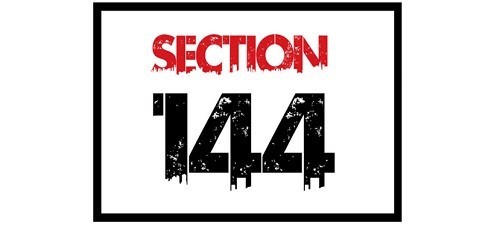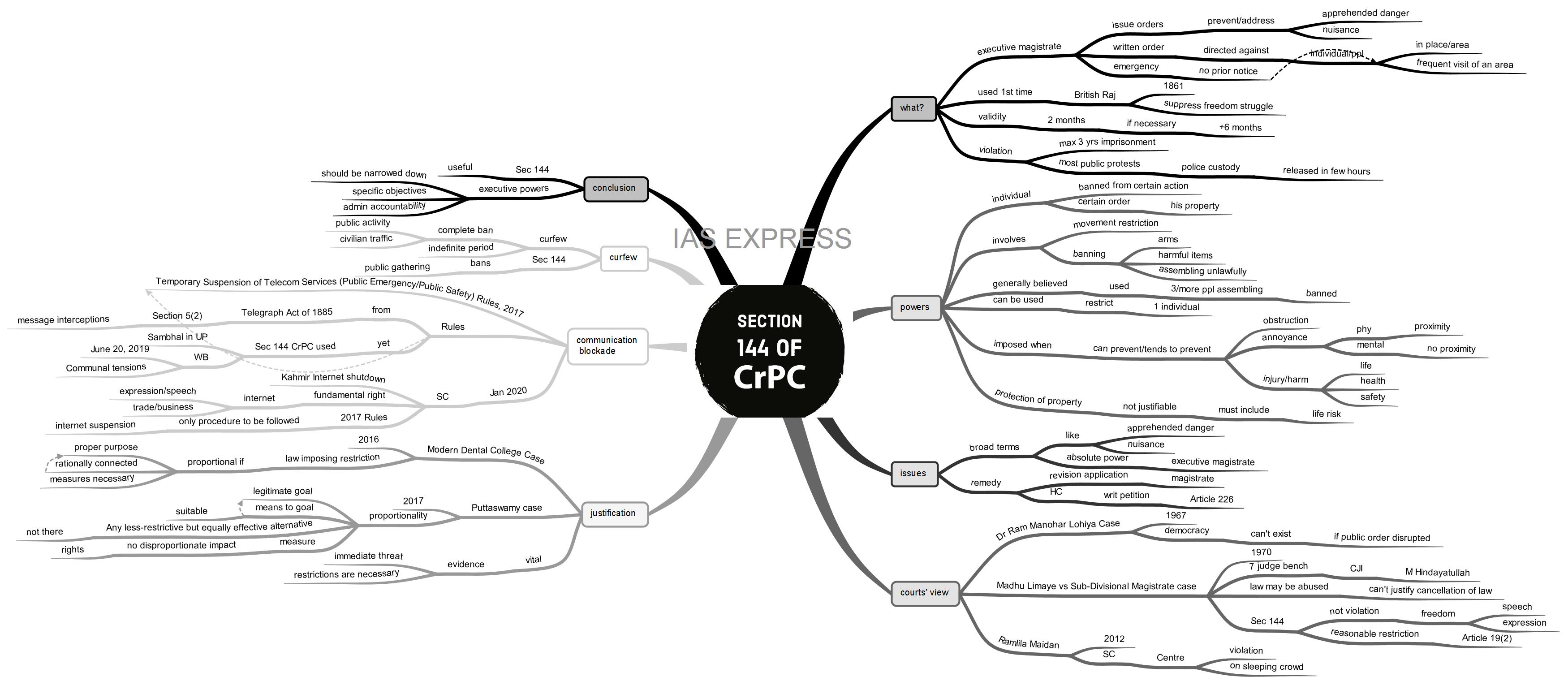Section 144 of Criminal Procedure Code (CrPC) – Explained

Section 144 CrPC was invoked by the police forces across the country to contain the nation-wide protests against the Citizenship Amendment Act. It is widely criticised for it conferring almost unbridled powers upon the executive officers. There are no limitations to the powers given to the executive officers and the concepts within this provision is too broad to make them accountable for their actions. Reforming this provision, in this regard, to gain public trust is necessary to ensure the balance between national security and democratic rights.
This topic of “Section 144 of Criminal Procedure Code (CrPC) – Explained” is important from the perspective of the UPSC IAS Examination, which falls under General Studies Portion.
What is Section 144?
- Section 144 of the Criminal Procedure Code (CrPC) of 1973 is a colonial-era law that empowers the executive magistrate to issue orders to prevent and address the urgent cases of apprehended danger or nuisance.
- The British Raj used Section 144 for the first time in 1861. Since then, it was used by the colonial government to suppress all the nationalist protests that had taken place in the struggle for independence.
- As per the law, the magistrate has to pass a written order, which may be directed against a particular individual or persons residing in a particular place or area or to the public generally when frequenting or visiting a particular place or area.
- In emergency cases, the magistrate can pass these orders without prior notice to the individual against whom the order is directed.
- No order passed under Section 144 can remain in force for more than two months from initiation of the order.
- It can be extended but not more than 6 months.
- Violation of Section 144 is liable for a maximum of 3 years imprisonment.
- However, in most cases involving public protests, as is the case with anti-CAA protests, the protestors are taken into custody by police and released after a few hours.
What powers does the magistrate have under the section144?
- The Magistrate can ban any person from undertaking certain activities.
- It can also issue a certain order concerning the specific property in his possession or under his management.
- It mostly involves the restriction of movement, carrying arms or items that can cause harm to life and property and from assembling unlawfully.
- It is generally believed that the assembly of three or more people is prohibited under Section 144.
- However, it can be used to restrict even a single individual.
- Such order can be imposed when the magistrate considers it is likely to prevent, or tends to prevent, obstruction, annoyance or injury to any person or cause harm to human life, health or safety, or a disturbance to public tranquillity.
- Annoyance here can be both physical and mental. For the physical annoyance, a certain degree of proximity of the object that is annoyed and annoyance is taken into consideration. For mental annoyance, there is no question of proximity. This section encompasses both these aspects.
- Furthermore, the magistrate does not have the power to make an order under this section merely for the protection of property. There must be some justification that the direction is likely to prevent injury or risk of injury to human life or safety.
What are the issues with Section 144 CrPC?
- This law is often criticised as the terms like “apprehended danger” or “nuisance” are wide enough to give absolute power to a magistrate so that it can be exercised unjustifiably.
- The immediate remedy of such an order is a revision application to the magistrate himself.
- An aggrieved individual can approach the High Court by filing a writ petition (Article 226) if his fundamental rights are threatened. However, fear still exists that before the HC can intervene, the fundamental rights could already be overstepped.
What are the courts’ points of view?
Dr. Ram Manohar Lohiya Case, 1967:
- The Supreme Court had stated that “no democracy can exist if ‘public order’ is freely allowed to be disrupted by a section of the citizens”.
Madhu Limaye vs Sub-Divisional Magistrate case, 1970:
- A seven-judge bench headed by the then Chief Justice of India M Hindayatullah had held the constitutionality of Section 144.
- The court stated that “law may be abused” is not justifiable to strike down a law.
- It further ruled that the restrictions imposed through the Section 144 can’t be held to be in violation of the right to freedom of speech and expression.
- It also stated that the restrictions imposed under Section 144 fall under the “reasonable restrictions” under Article 19(2) of the Constitution.
Ramlila Maidan, 2012:
- In 2012, the apex court had criticised the Centre for imposing Section 144 against the sleeping crowds in Ramlila Maidan.
- It was held that such provisions could be used only in grave circumstances for maintaining the public peace. The emergency must be sudden and the consequences sufficiently grave.
What can justify the imposition of Section 144?
- To determine whether the restrictions on liberties guaranteed under Article 19 are reasonable or not, the apex court has developed the “test of proportionality”.
- In the Modern Dental College Case (2016), the Supreme Court held that a law imposing restrictions will be treated as proportional if:
- It is meant to achieve a “proper purpose”,
- The measures taken to achieve such purpose are “rationally connected to the purpose”, and
- Such measures are “necessary”.
- In the Puttaswamy case (2017), the apex court had provided for a test to define proportionality:
- Legitimate goal stage: A measure that restricts the rights must have a legitimate goal.
- Suitability or rationale connection stage: It should be a suitable means for furthering the legitimate goal.
- Necessity stage: Any less restrictive but equally effective alternative must not be present while taking this measure.
- Balancing stage: The measure must not have a disproportionate impact on the rights of the individual.
- So, the legality of the orders passed under section 144 CrPC will be tested based on the aforementioned principles of ‘reasonableness’ and ‘proportionality’.
- Thus, the past rulings of the judiciary, when analysed along with the doctrine of proportionality, lead to the conclusion that an order under Section 144 can be imposed only if there is evidence that:
- There is an immediate threat
- The restrictions are necessary to prevent the immediate threat.
Does Section144 provide for communication blockade too?
- The rules for suspending communication services, which include voice, mobile internet, SMS, landline, fixed broadband etc., are provided under the Temporary Suspension of Telecom Services (Public Emergency or Public Safety) Rules, 2017.
- These rules derive their powers from the Indian Telegraph Act of 1885, Section 5(2) which talks about the interception of messages in the “interests of the sovereignty and integrity of India”.
- However, shutdowns in India were not always under the rules laid down, which come with safeguards and procedures.
- Section 144 CrPC has often been used to clamp down telecommunication services and order internet shutdowns.
- In Sambhal in Uttar Pradesh, the District Magistrate, under Section 144, suspended internet services.
- In West Bengal, on June 20, 2019, the District Magistrate under Section 144, had shut down mobile internet, cable services and broadband over communal tensions.
- In January 2020, the Supreme Court had declared that the fundamental right to freedom of speech and expression and the right to carry on trade or business using the internet are constitutionally protected.
- This came in response to the on-going five-month-long internet shutdown in Kashmir.
- The court had recognised that the 2017 Rules are the only procedure to be followed to suspend the internet services in case of a “public emergency”.
What is the difference between Section 144 and curfew?
- Curfew and Section 144 are different though both of them are issued by the District Magistrate.
- Under the curfew, public activity and civilian traffic are completely banned. It may be imposed depending on the situation and possibilities of large riots or violence and can be extended for an indefinite period.
- Section 144, on the other hand, prohibits public gathering for two months and can be extended to only a maximum period of an additional 6 months. It can be withdrawn whenever the administration feels the situation has improved.
Conclusion
Section 144 has been imposed for many years now to address the problem of the possibility of riots and violence and it has proven to be an efficient tool to deal with emergencies. However, the absence of any narrow tailoring of wide executive powers with specific objectives, coupled with very limited judicial oversight over the executive branch, makes it ripe for abuse and misuse. The narrowing down of the executive powers and providing for accountability for the administrations’ actions are vital for the securing of the democracy.
Test Yourself
What is Section 144 of CrPC? What are the limitations of this provision and what can be done to address it? (250 Words)



Why i can’t copy text.